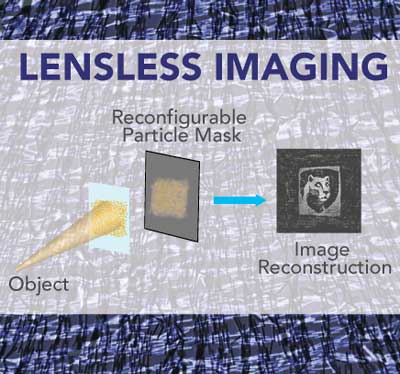| Sep 23, 2020 | |
A multishot lensless camera in development could aid disease diagnosis(Nanowerk News) A new type of imaging that does not require a lens and uses reconfigurable particle-based masks to take multiple shots of an object is being developed by researchers at Penn State. The electric-field directed self-assembling mask technology is expected to have uses in lower-cost and faster disease diagnosis, the enhancement of optical microscopy, and may even lead to thinner cellphone technology. |
|
How it works |
|
| The researchers create a mask of microscopic gold wires and place it near the object that will be imaged. The mask scatters the light reflected off the object and an image sensor collects the light. An electric current rearranges the particles in the mask, producing a new mask with every iteration, and the system records each new image. The multiple light captures are then computationally reconstructed into the original object image, resulting in highly improved resolution and quality. | |
 |
|
| Schematic of the layout for a lensless camera. (Image: Keating/Liu Labs, Penn State) | |
| “We are not the only group to do lens-free imaging,” explained Jennifer Miller, a doctoral candidate in chemistry and a first author on a paper recently published online in ACS Nano ("Particle-Based Reconfigurable Scattering Masks for Lensless Imaging"). “What is different about our work is that typically you would need to make multiple masks and physically move them around to get multiple images. This becomes bulky and expensive and negates some of the simplicity that is the advantage of lens-free imaging.” | |
| In typical microscopy, there exists a trade-off between the field of view and the power of the resolution, so a 10x field is wider than a100x field. By using a lens-free imaging technology, it is possible to combine a wide field of view with high magnification for lower-cost images and faster diagnosis of disease. This could be especially useful in developing countries where high-end microscopes are not available. | |
| “Traditional masks are passive," said co-first author Cheng-Yu Wang, doctoral candidate in electrical engineering. "We can add functionalization to our microwire, like polarization, selectivity and plasmonic effects, that make our imaging system more powerful.” | |
| In the case of cellphones, one major contributor to their bulk is due to the camera lens needing to be a certain distance to the detector. A lens-free camera could help minimize the space requirement. Likewise, a lens-free system added to a cellphone could turn the cellphone into a low-power microscope. |
| Source: Penn State | |
|
Subscribe to a free copy of one of our daily Nanowerk Newsletter Email Digests with a compilation of all of the day's news. |
